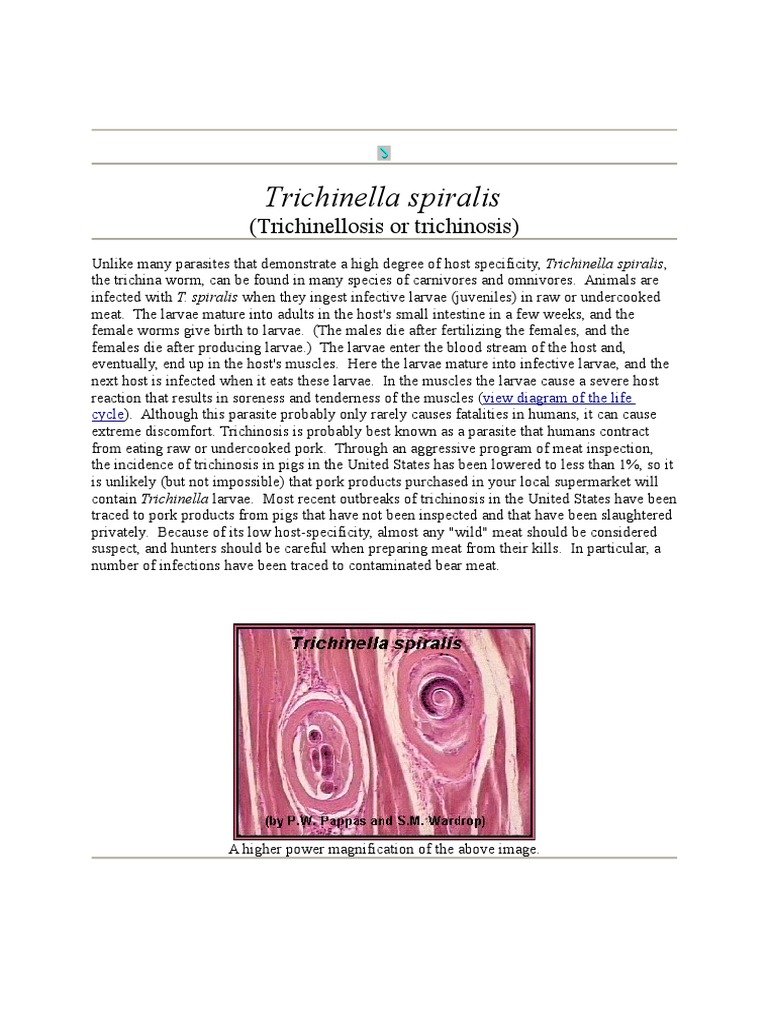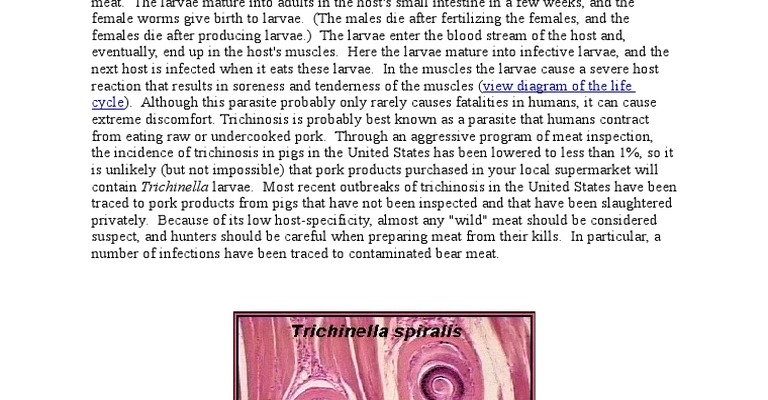
Imagine biting into a sausage at a barbecue, completely unaware that it’s harboring these little worms. Trichinella spiralis can be present in the muscle tissue of infected animals, often pigs, and if we don’t cook our food thoroughly, we’re at risk. So, let’s dive deeper into the documented range and distribution of this parasitic player. We’ll explore where it’s found, how it spreads, and what this means for us as consumers.
Understanding Trichinella Spiralis
To grasp the range and distribution of Trichinella spiralis, it’s essential first to understand what it is. This parasite is a nematode, or roundworm, that can invade the muscles of various mammals. It’s notorious for causing trichinosis, a disease that can result from consuming undercooked meat containing its larvae. When someone eats infected meat, these larvae can hatch in the intestine, grow, and then migrate to muscles, where they can remain for years.
The life cycle of Trichinella spiralis is quite fascinating. It starts when a host animal, often a pig, eats raw or undercooked meat containing the larvae. These larvae then hatch in the small intestine, mate, and produce new larvae, which travel through the bloodstream to muscle tissues. Once in the muscles, they encyst, waiting for another host to consume them. It’s a classic case of a cycle that keeps on going!
Global Distribution of Trichinella Spiralis
Trichinella spiralis is not just a problem in one corner of the world—it has a documented presence across various continents. Traditionally, it has been most prevalent in regions where pork consumption is high and cooking practices might not kill the larvae. Countries in parts of Europe, Asia, and some regions of the Americas have recorded cases of trichinosis due to this parasite.
Studies have shown that Trichinella spiralis is commonly found in places like China, Russia, and certain areas in the United States. These regions still experience outbreaks, particularly in rural areas where there is less awareness about safe cooking practices. It’s intriguing how culture and food habits play such a significant role in the spread of this parasite.
Factors Influencing Distribution
So, what exactly affects where Trichinella spiralis can be found? There are several factors at play. First and foremost, food culture is a biggie. In countries where pork is a staple, the likelihood of consuming undercooked meat rises, leading to higher infection rates. For instance, in many Eastern European countries, traditional dishes might not always prioritize thorough cooking.
Another crucial factor is hygiene and sanitation practices in farming and food preparation. Regions with stringent hygiene regulations usually see fewer cases of trichinosis. Proper regulations can help prevent infected animals from entering the food supply. Similarly, educating farmers and consumers about the importance of cooking meat to safe temperatures can drastically reduce the risk of infection.
Lastly, environmental conditions also play a role. Trichinella spiralis can survive in the environment for a while, especially in conditions that favor its life cycle. For example, areas with a lot of wildlife can serve as reservoirs for the parasite, contributing to its spread. In this way, nature and human activity go hand in hand in shaping the distribution of this parasite.
Trichinella Spiralis in Domestic Animals
When we talk about Trichinella spiralis, it’s essential to mention its home in domestic animals. Pigs are the primary host for this parasite, but it can also infect wild animals like bears and rodents. The connection between wild and domestic animals is something we can’t overlook.
In many rural areas, pigs might have access to uncooked scraps, including the meat of infected animals. This practice boosts the chances of Trichinella spiralis being introduced into the domestic pig population. Once infected, these pigs can then transmit the parasite to humans through undercooked pork.
Moreover, in regions where hunting is common, the consumption of wild game infected with Trichinella spiralis poses additional risks. A hunter might not think twice about cooking that wild boar they just caught, but if it’s not cooked properly, they could end up with a serious case of trichinosis.
Health Impacts of Trichinella Spiralis
Understanding the health implications of Trichinella spiralis is crucial for awareness and prevention. When a person consumes undercooked meat containing this parasite, they can develop trichinosis, which comes with a range of symptoms. Initially, the symptoms might be mild, such as nausea or diarrhea. However, as the larvae migrate to the muscles, more severe symptoms like muscle pain, fever, and swelling can set in.
It’s not just about feeling unwell; trichinosis can lead to serious health complications if left untreated. In extreme cases, it can even be life-threatening. This makes awareness and education so important. Knowing how to prepare meat safely and being cautious about food choices can help minimize risks significantly.
Here’s the thing: many cases of trichinosis can be prevented with proper cooking. The FDA recommends cooking pork to an internal temperature of at least 145°F (about 63°C), followed by a three-minute rest time before carving or consuming. By following these guidelines, you can help protect yourself and your loved ones from this nasty parasite.
Preventing Trichinella Spiralis Infections
Prevention starts with education, and there are simple steps everyone can take to avoid becoming a host to Trichinella spiralis. First, always cook meat thoroughly. As mentioned, cooking pork to the right temperature is essential. If you’re unsure, using a meat thermometer is a great way to ensure that your food is safe to eat.
Next, practicing good hygiene in the kitchen can make a big difference. Wash your hands, utensils, and surfaces after handling raw meat. It might seem basic, but these practices can stop cross-contamination, reducing the risk of infection.
Lastly, consider where your meat comes from. Purchasing meat from reputable sources that follow safe farming practices can lower your risk. Understanding how your food is raised and processed allows you to make more informed choices. It’s all about being proactive rather than reactive!
The Future of Trichinella Spiralis Research
Looking ahead, research on Trichinella spiralis continues to evolve. Scientists are examining new methods for detecting the parasite in food sources and studying its life cycle to better understand how it spreads. Advances in technology, such as genetic sequencing, could open up new doors for understanding this parasite’s distribution patterns.
Furthermore, public health initiatives are increasingly focused on educating people about the risks associated with undercooked meats. This means we might see more awareness campaigns aimed at reducing the incidence of trichinosis. The more people know, the safer and healthier our food systems can become.
As we move into a world that prioritizes health and safety, we can hope that the documented range and distribution of Trichinella spiralis becomes a thing of the past, replaced by safe and enjoyable eating experiences for everyone.
In conclusion, while Trichinella spiralis may seem like a hidden menace, understanding its range, and distribution helps us combat it effectively. By cooking meat properly, practicing good hygiene, and staying informed about food sources, we can protect ourselves and continue to enjoy the delicious meals we love.

